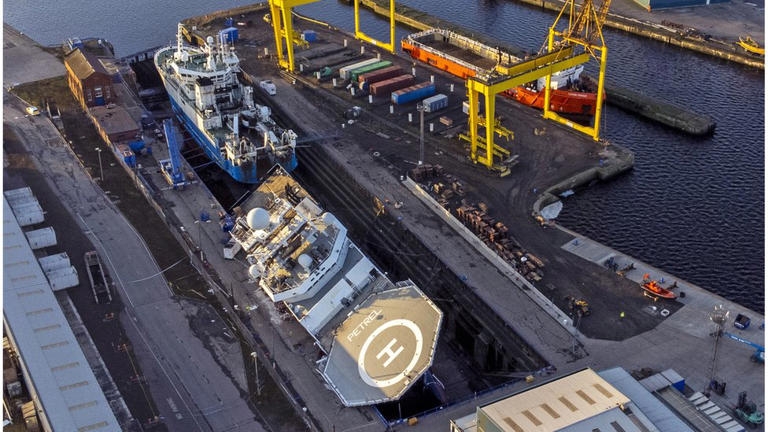‘Canada should not dump garbage where you draw your water’: chief
Safeguarding water near a planned nuclear waste facility requires more rigorous examination, Indigenous consultation and mitigation measures, an Algonquin First Nation chief told a federal committee Thursday.
In testimony before the Standing Committee on Environment and Sustainable Development, Kebaowek Chief Lance Haymond said, “Canada should not dump garbage where you draw your water.”
The committee hearing is part of a larger study on freshwater issues across Canada.
“I want to talk about a project poisoning the Ottawa River,” he explained while describing the cultural and historical importance of the waterway to the Algonquin nation. “The Kichi Sibi, as we call it … has been our highway for time immemorial.”
Haymond told the committee that he asked Ottawa to hold back permits issued two weeks ago to Canadian Nuclear Laboratories (CNL), which is developing the facility. The permits allow CNL to move forward with construction despite risks to Blanding's turtles and two bat species. Haymond told Canada’s National Observer that the permits amount to a kill order.
In January, Kebaowek First Nation urged the federal government to withhold SARA [Species at Risk Act] permits due to “insufficient consideration” of the impact on at-risk species and the First Nation’s rights and responsibilities to protect endangered species on their ancestral territory.
But the federal government’s review determined that construction of CNL’s radioactive waste disposal facility won’t jeopardize the recovery of endangered turtle and bat populations.
The committee testimony arrives amidst a court challenge launched by Kebaowek First Nation in February. The court challenge questions whether the United Nations Declaration on the Rights of Indigenous Peoples (UNDRIP) was properly considered by nuclear regulators before approval of the Chalk River waste disposal facility.
“The consultation process, however, was flawed from the outset,” suggests the Federal Court application launched by Kebaowek. “It was not procedurally fair and did not consider the UN Declaration, Canada’s UNDRIP Implementation Act, or how these instruments might affect the depth and scope of consultation.”
CNL gave Kebaowek nine months to provide input, and the nation offered it through an Algonquin-led environmental assessment, Haymond told the committee.
However, he believes enough time for consultation was not given and that “most decisions had already been taken.”
“We were routinely scoped out of the process,” he added. “If we were consulted, we would have asked for other site selections."
Haymond brought forward concerns about tonnes of nuclear waste stored in the facility that might leach from the site into the Ottawa River over the next few hundred years once synthetic containment liners break down.
Haymond also brought up Chalk River’s history, beginning with its role in the Manhattan Project developing plutonium in the early 1940s and leading to the world’s first nuclear reactor meltdown in 1952. Algonquin nations were never consulted about a nuclear research facility at that time, he said.
— With files from Natasha Bulowski
Matteo Cimellaro / Canada’s National Observer / Local Journalism Initiative
Matteo Cimellaro, Local Journalism Initiative Reporter, Canada's National Observer
Story by The Canadian Press • 20h •
Construction on Canadian Nuclear Laboratories’ radioactive waste disposal facility won’t jeopardize the recovery of endangered turtle and bat populations, according to the federal government.
On March 18, Canadian Nuclear Laboratories (CNL) was granted a federal permit required under the Species at Risk Act (SARA) to start construction on its near-surface waste facility (NSDF) about 180 kilometres northwest of Ottawa.
For the permit, three endangered species were considered: the Blanding’s turtle, the little brown bat and the northern long-eared bat.
Ultimately, the company’s permit application was approved in mid-March by the Canadian Wildlife Service (CWS), a branch of Environment and Climate Change Canada.
The decision by CWS said CNL successfully demonstrated feasible measures will be taken to minimize the impact of construction on the three species and construction will not jeopardize their recovery.
Some measures will include identifying turtle and bat hot spots, “creation of turtle-crossing systems,” installation of temporary fencing around construction areas and permanent fencing along roadways, according to the decision.
“The alternative of not proceeding with the activity is not compatible with the government’s obligations and commitments of substantially reducing the risks associated with nuclear legacy waste or with the objective of creating opportunities for the revitalization of the Chalk River Laboratories,” reads the decision. The project’s location and footprint were chosen to minimize impacts to these species, it noted.
Blanding’s turtles and two species of bats are not the only creatures some First Nations and environmental groups are concerned about. In January, Kebaowek First Nation urged the federal government to withhold SARA permits due to “insufficient consideration” of the impact on at-risk species and the First Nation’s rights and responsibilities to protect endangered species on their ancestral territory. Kebaowek Chief Lance Haymond pointed to Algonquin-led studies that found black bear dens and eastern wolf pups were at risk.
Eastern wolves are listed as threatened in Ontario, but not at the federal level, so construction or activities on their habitat do not require a SARA permit.
Gretchen Fitzgerald, national programs director at Sierra Club Canada Foundation, wrote to Environment and Climate Change Minister Steven Guilbeault earlier this year asking him to instruct the department to wait until the impacts on other animals, including migratory birds and eastern wolves, are “thoroughly assessed” before issuing a SARA permit.
She called the permit a “terrible decision” and hopes “the minister will take a second look and listen to the Kebaowek First Nation and others who are calling for more work to be done to identify and protect habitat for endangered species, including wolves, that can be found at the site,” said Fitzgerald in an emailed statement to Canada’s National Observer.
In 2015, the Committee on the Status of Endangered Wildlife in Canada assessed the eastern wolf as threatened due its restricted range and small population. If this wolf, currently listed as a species of special concern, was formally recognized as threatened, their habitat would have to be protected and could include the NSDF site. The federal government must make a decision on the eastern wolves’ status by August.
During one of several consultations on eastern wolves, CNL said it would cost up to $160 million if the NSDF project was cancelled and planning and approval processes started from scratch.
Kebaowek Coun. Justin Roy said the Algonquin-led studies identified active bear dens and wolves as recently as last summer and provided photos and videos of the animals’ activities from cameras previously installed at the site.
— With files from Matteo Cimellaro
Natasha Bulowski, Local Journalism Initiative Reporter, Canada's National Observer











